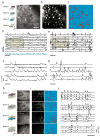Simultaneous two-photon calcium imaging at different depths with spatiotemporal multiplexing
- PMID: 21217749
- PMCID: PMC3076599
- DOI: 10.1038/nmeth.1552
Simultaneous two-photon calcium imaging at different depths with spatiotemporal multiplexing
Abstract
In vivo two-photon calcium imaging would benefit from the use of multiple excitation beams to increase scanning speed, signal-to-noise ratio and field of view or to image different axial planes simultaneously. Using spatiotemporal multiplexing we circumvented light-scattering ambiguity inherent to deep-tissue multifocal two-photon microscopy. We demonstrate calcium imaging at multiple axial planes in the intact mouse brain to monitor network activity of ensembles of cortical neurons in three spatial dimensions.
Conflict of interest statement
COMPETING FINANCIAL INTERESTS
The authors declare no competing financial interest
Figures



References
-
- Svoboda K, Yasuda R. Principles of two-photon excitation microscopy and its applications to neuroscience. Neuron. 2006;50:823–839. - PubMed
-
- Kremer Y, et al. A spatio-temporally compensated acousto-optic scanner for two-photon microscopy providing large field of view. Opt Express. 2008;16:10066–10076. 164908 [pii] - PubMed
Publication types
MeSH terms
Substances
Grants and funding
LinkOut - more resources
Full Text Sources
Other Literature Sources

